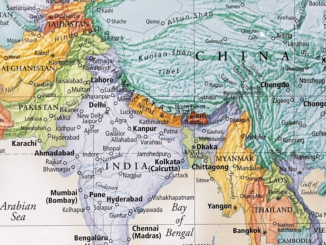Over the past few years, the US has been left in a state of deep insecurity, and with China’s steady rise, the US has begun to view China as an adversary through the lens of the Cold War. Just as in the Cold War, Washington’s playbook so far has been driven by fear and then confrontation. This is not a new phenomenon; it is a textbook scenario of the Thucydides Trap, where a hegemon feels threatened by an up-and-coming challenger, and the consequences are often violent, whether deliberate or not. The concept was coined by the ancient Greek historian Thucydides in his study of the Peloponnesian War and introduced to the contemporary discourse by a Harvard scholar, Graham Allison. Allison examined 16 instances of power transition over the past 500 years; twelve of those resulted in war. The established hegemon strikes back most times in an irrational manner. The trade war between the US and China that was started by the Trump administration in 2018 was the contemporary representation of this fear.
The economic and military dominance of the US had gone unchallenged for several years after the downfall of the USSR. The post-Cold War unipolarity affirmed it as the “indispensable nation.” The rapid ascendency of China as a manufacturing hub to a high-tech economy with a focus on innovation has caught Washington on the back foot. The global rise of China in industries such as 5G, artificial intelligence, green energy, and infrastructure laid through the construction of the Belt and Road Initiative demonstrates another model of global growth, divergent from the Washington Consensus. Under President Trump, the U.S. chose confrontation instead of adopting multipolarity or cooperation. Hundreds of billions of dollars’ worth of Chinese goods were slapped with tariffs. The target companies were tech companies such as Huawei and ZTE. There was more scrutiny directed at Chinese students and scholars. The ostensible reason was to address unfair trade balances, yet the real reason was strategic containment.
Fast-forward to 2025. A few years of economic stagnation, inflationary pressure, and weakening global supply chains have forced Washington to reassess. The new Trump campaign and his aides have begun to strike a more conciliatory tone. Why the change of heart?
The trade war has damaged American consumers and businesses. Tariffs increased the prices of goods of manufacturers based in the US, as well as affected the supply chains and led to inflation. Secondly, the domestic economic recovery of America out of the COVID-19 era has not been inspiring. The trade flows need stabilization and re-entry into a world economic system in which China should be central. Besides, there has been increasing international pressure. Washington’s allies in Europe and Southeast Asia have been tired of the confrontational stance taken by Washington; thus, they want to engage China. Even Wall Street, which usually has a strong influence over American foreign policy making, has come out lobbying for a détente, now looking into the Chinese markets with fresh interest.
Behind-the-scenes negotiations have been intense in recent months. In June 2025, both Washington and Beijing had settled on a framework of lowering tariffs imposed on each other: Washington would not raise its tariffs, but Beijing would ease tariffs on important U.S. imports and lower them to 10%. A diplomatic window was established as both sides committed to maintaining this truce until August 12, 2025, through which they might seal a longer-term agreement. More importantly, we have seen some activity in the tech space, one of the battlefields of the war. The U.S. issued limited licenses to Nvidia and other companies to restart some unspecified exports of semiconductors to China, acknowledging not only the business interests but also the stabilizing effects of tech interdependence.
China, in its turn, has proved to be mature and strategically patient. Beijing has never given up dialogue regardless of the sanctions and provocation. It has repeatedly appealed to the restoration of normal and stable relations between the US and China based on mutual respect and win-win proposals. These appeals, which long have been unheeded, are at last being listened to by Trump 2.0.
The rising possibility of Donald Trump visiting China later this year is one of the greatest indicators of the US posture change. The occasion in question? On September 3rd, 2025, the 80th anniversary celebration of the Chinese victory in the war of resistance against Japanese aggression. Although Chinese officials have not yet officially announced any invitation, diplomatic sources report that negotiations are ongoing. A visit of such kind, in case it becomes possible, would be a strategic and symbolic giant. By doing this, Trump already had a chance to re-pack himself as more than a dealmaker, but as a peacemaker. In the case of China, it would help to confirm that it is a mature, central participant in international governance that could even deal with challenging partners.
In addition to bilateral relations, a US-China reset would have a profound effect on the world economy and peace. The World Trade Organization and the OECD estimate that a sustained tariff rollback would increase global trade by 250 to 300 billion per year and increase global GDP growth by 0.3 to 0.4 percentage points over the next two years. The industries that will be aided are those of agriculture, semiconductors, electric vehicles, and green technology, as these are industries that will help in addressing issues of food security, climate change, and sustainable development.
Concrete economic accords and a Trump visit could provide global markets with revival, stabilize commodity prices, and get the momentum going. It would exhibit that even the most powerful nations can choose dialogue over dominance, and maturity over military aggression. Through this whole saga, China has demonstrated superlative restraint and wisdom. Instead of following the aggressive rhetoric of the US, Beijing promoted the idea of cooperation, economic openness, and sovereign leadership. The U.S. lingered between belligerence and reluctance, but China was steadfast in its approach: there was always an open door to dialogue, just not on the terms of humiliation. If the Thucydides Trap is to be avoided this time around, it will be due to China’s continued restraint and Trump’s renewed aspiration to be seen as a peacemaker and deal maker.
In a world today that is showing intense signs of volatility, the Ukraine conflict, Pakistan-India conflict, May 2025, the 12-day Israel-Iran war, the destruction of Gaza, it is high time for the big boys, China and the US, to show the world that peace and dialogue are the way forward. Such a move would have a profound impact, helping to ease the temperature of the growing global polarization we see today. Breaking the Thucydides Trap is not simple; nevertheless, it can happen. It only requires vision, pragmatism, and leadership. Should Donald Trump travel to Beijing this fall and promise to redefine relations with China, not as an act of weakness, but as a step towards pragmatism and world peace, then it might be recalled as one of the watershed moments of 21st-century diplomacy. The world is waiting and watching cautiously with a bit of hope, at least at this time.




Be the first to comment